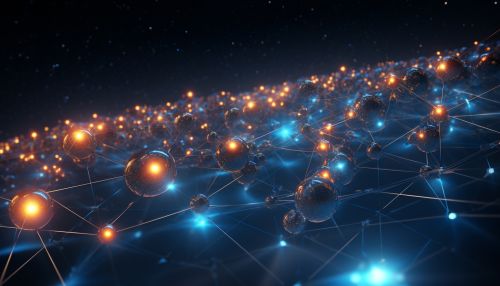Quantum Networks
Introduction
Quantum networks represent a new frontier in information technology, leveraging the principles of quantum mechanics to create secure, high-speed communication systems. These networks use quantum entanglement and superposition to transmit data, offering potential advantages over traditional networks in terms of speed, security, and computational power.


Quantum Mechanics and Quantum Networks
Quantum mechanics is the branch of physics that deals with the smallest particles in the universe, such as atoms and subatomic particles like electrons and photons. It is characterized by the principles of superposition and entanglement, which are fundamental to the operation of quantum networks.
Superposition
Superposition is a principle of quantum mechanics that states that a quantum system can exist in multiple states at once. This is in stark contrast to classical systems, which can only exist in one state at a time. In the context of quantum networks, superposition allows for the simultaneous transmission and processing of multiple bits of information.
Entanglement
Quantum entanglement is a phenomenon where two or more particles become linked, such that the state of one particle instantaneously affects the state of the other, regardless of the distance between them. This property is used in quantum networks to create secure communication channels, as any attempt to intercept or alter the data would immediately be detected.
Quantum Network Architecture
The architecture of a quantum network is fundamentally different from that of a classical network. While classical networks use routers and switches to direct data packets, quantum networks use quantum nodes and quantum links.
Quantum Nodes
Quantum nodes are the basic building blocks of a quantum network. These nodes are capable of generating, storing, and manipulating quantum states. They can also perform quantum operations such as the creation of entangled states and quantum gates.
Quantum Links
Quantum links are the connections between quantum nodes. These links are used to transmit quantum states between nodes. The transmission is done using quantum particles such as photons, which are capable of maintaining their quantum state over long distances.
Quantum Network Protocols
Just as classical networks have protocols to regulate data transmission, quantum networks also have their own unique protocols. These protocols are designed to take advantage of the unique properties of quantum mechanics, such as superposition and entanglement.
Quantum Key Distribution
One of the most well-known quantum network protocols is Quantum Key Distribution (QKD). QKD uses the principles of quantum mechanics to create secure encryption keys. The security of QKD comes from the fact that any attempt to intercept or measure the key would disturb the quantum state of the system, alerting the communicating parties to the presence of an eavesdropper.
Quantum Teleportation
Quantum teleportation is another protocol used in quantum networks. This protocol allows for the transmission of quantum states from one location to another without the physical transport of the quantum particle itself. This is achieved through the use of entangled particles and a classical communication channel.
Applications of Quantum Networks
Quantum networks have a wide range of potential applications, from secure communications to distributed quantum computing.
Secure Communications
One of the primary applications of quantum networks is in secure communications. The use of quantum key distribution protocols allows for the creation of encryption keys that are theoretically unbreakable, providing a level of security beyond what is possible with classical networks.
Distributed Quantum Computing
Quantum networks also have potential applications in distributed quantum computing. By connecting multiple quantum computers together via a quantum network, it may be possible to create a distributed quantum computing system with significantly greater computational power than a single quantum computer.
Future of Quantum Networks
While quantum networks are still in their early stages of development, they hold significant promise for the future of information technology. As our understanding of quantum mechanics continues to grow, and as technology continues to advance, it is likely that quantum networks will become an increasingly important part of our digital infrastructure.
